Characterization of Particulate Matter in Indoor Air from Cooking Activities in Rural Indonesian Households
Abstract
1. Introduction
2. Methodology
2.1. Study Area and Household Selection
2.2. Monitoring Period and Cooking Conditions
2.3. Sensor Specifications and Data Output
2.4. Data Analysis
2.5. Health Risk Estimation
3. Results and Discussion
3.1. Real-Time Mass Concentration of PM
3.2. Size-Segregated Number Concentration of PM
3.3. Size-Segregated Number Concentration and Correlation Among PM Parameters in Relation to Cooking Activities
4. Conclusions and Recommendation
Supplementary Materials
Author Contributions
Funding
Institutional Review Board Statement
Informed Consent Statement
Data Availability Statement
Acknowledgments
Conflicts of Interest
References
- Gilbey, S.E.; Reid, C.M.; Zhao, Y.; Soares, M.J.; Rumchev, K.B. Factors affecting indoor environmental air quality of non-smoking residences in Perth, Western Australia. Indoor Built Environ. 2023, 32, 961–976. [Google Scholar] [CrossRef]
- Morino-Rangel, A.; Baek, J.; Roh, T.; Xu, X.; Carrillo, G. Assessing impact of household intervention on indoor air quality and health of children with asthma in the US-Mexico border: A pilot study. J. Environ. Public Health 2020, 2020, 6042146. [Google Scholar] [CrossRef] [PubMed]
- Tahir, A.; Abbasi, N.A.; He, C.; Ahmad, S.R. Exposure and human health risk assessment of chlorinated paraffins in indoor and outdoor dust from a metropolitan city, Lahore, Pakistan. Chemosphere 2023, 340, 140687. [Google Scholar] [CrossRef] [PubMed]
- Kaewrat, J.; Janta, R.; Sichum, S.; Kanabkaew, T. Indoor air quality and human health risk assessment in the open-air classroom. Sustainability 2021, 13, 8302. [Google Scholar] [CrossRef]
- Kuehn, B.M. WHO: More than 7 million air pollution deaths each year. JAMA 2014, 311, 1486. [Google Scholar] [CrossRef]
- Azad, S.; Bahauddin, K.M.; Uddin, M.H.; Parveen, S. Indoor air pollution and prevalence of acute respiratory infection among children in rural area of Bangladesh. J. Biol. Agric. Healthc. 2014, 4, 60–71. [Google Scholar]
- Krishnamoorthy, Y.; Sarveswaran, G.; Sivaranjini, K.; Sakthivel, M.; Majella, M.G.; Kumar, S. Association between indoor air pollution and cognitive impairment among adults in rural Puducherry, South India. J. Neurosci. Rural. Pract. 2018, 9, 529–534. [Google Scholar] [CrossRef]
- Rajper, S.A.; Nazir, A.; Ullah, S.; Li, Z. Perceived health risks of exposure to indoor air pollution from cooking fuels in Sindh, Pakistan. Pol. J. Environ. Stud. 2020, 29, 2833–2844. [Google Scholar] [CrossRef]
- Mannan, M.; Al-Ghamdi, S.G. Indoor air quality in buildings: A comprehensive review on the factors influencing air pollution in residential and commercial structure. Int. J. Environ. Res. Public Health 2021, 18, 3276. [Google Scholar] [CrossRef] [PubMed]
- Clark, M.L.; Reynolds, S.J.; Burch, J.B.; Conway, S.; Bachand, A.; Peel, J.L. Indoor air pollution, cookstove quality, and housing characteristics in two Honduran communities. Environ. Res. 2010, 110, 12–18. [Google Scholar] [CrossRef]
- Lee, H.; Pan, C.; Hsu, H. Indoor air quality and improvement strategies of using mechanical ventilation in confined spaces. In Proceedings of the 2023 9th International Conference on Applied System Innovation (ICASI), Chiba, Japan, 21–25 April 2023; pp. 261–263. [Google Scholar]
- Indu, G.; Sm, S.N.; Mahesh, P.A. Indoor air pollution in rural south Indian kitchens from biomass-fuel usage and the predicted lung deposition in women. Atmos. Environ. 2024, 336, 120732. [Google Scholar] [CrossRef]
- Sonntag, D.B.; Jung, H.; Harline, R.P.; Peterson, T.C.; Willis, S.E.; Christensen, T.R.; Johnston, J.D. Infiltration of Outdoor PM2.5 Pollution into Homes with Evaporative Coolers in Utah County. Sustainability 2024, 16, 177. [Google Scholar] [CrossRef]
- Nkosi, V.; Wichmann, J.; Voyi, K.V. Indoor and outdoor PM10 levels at schools located near mine dumps in Gauteng and North West Provinces, South Africa. BMC Public Health 2017, 17, 42. [Google Scholar] [CrossRef]
- Yun, H.; Seo, J.H.; Yang, J. Development of particle filters for portable air purifiers by combining melt-blown and polytetrafluoroethylene to improve durability and performance. Indoor Air 2024, 2024, 5055615. [Google Scholar] [CrossRef]
- Yun, H.; Seo, J.H.; Kim, Y.G.; Yang, J. Impact of scented candle use on indoor air quality and airborne microbiome. Sci. Rep. 2025, 15, 5543. [Google Scholar] [CrossRef] [PubMed]
- Lado, E.P.; Awiti, J.O.; Mwai, D. The effect of indoor air pollution on under-five child health in South Sudan. BMC Public Health 2025, 25, 2124. [Google Scholar] [CrossRef]
- Kim, S.; Gurmu, B.L.; Kim, M.; Song, C.; Lee, M.; Lim, C.C.; Rule, A.M.; Yang, K.I. Effect of indoor air quality on potential risk of obstructive sleep apnea: Results from Korea National Health and Nutrition Examination Survey. BMC Public Health 2025, 25, 1306. [Google Scholar] [CrossRef]
- Muoth, C.; Grossgarten, M.; Karst, U.; Ruiz, J.; Astruc, D.; Moya, S.E.; Diener, L.; Grieder, K.; Wichser, A.; Jochum, W.; et al. Impact of particle size and surface modification on gold nanoparticle penetration into human placental microtissues. Nanomedicine 2017, 12, 1119–1133. [Google Scholar] [CrossRef]
- Löndahl, J.; Wollmer, P.; Gudmundsson, A.; Nicklasson, H.; Swietlicki, E.; Rissler, J. Measurement of respiratory tract deposition of inhaled particles (0.015–5 µm), lung function and breathing pattern for a group of 67 adults and children. Eur. Respir. J. 2017, 50, PA2638. [Google Scholar]
- Chen, L.; Yousaf, M.; Xu, J.; Ma, X.; Zhou, X.; Li, G.; Symonds, J.; Chen, R.; Tang, S.; Salehi, F.; et al. Ultrafine particles deposition in human respiratory tract: Experimental measurement and modeling. Ecotoxicol. Environ. Saf. 2025, 295, 118123. [Google Scholar] [CrossRef]
- Singh, L.; Agarwal, T. Polycyclic aromatic hydrocarbons (PAHs) exposure through cooking environment and assessment strategies for human health implications. Hum. Ecol. Risk Assess. Int. J. 2022, 28, 635–663. [Google Scholar] [CrossRef]
- Feng, R.; Xu, H.; Gu, Y.; Gao, M.; Bai, Y.; Liu, M.; Shen, Z.; Sun, J.; Qu, L.; Hang Ho, S.S.; et al. Deposition effect of inhaled particles in the human: Accurate health risks of personal exposure to PAHs and their derivatives from residential solid fuel combustion. Atmos. Environ. 2023, 294, 119510. [Google Scholar] [CrossRef]
- Arcenas, A.L.; Bojö, J.; Larsen, B.K.; Ruiz Ñunez, F. The economic costs of indoor air pollution: New results for Indonesia, the Philippines, and Timor-Leste. J. Nat. Resour. Policy Res. 2010, 2, 75–93. [Google Scholar] [CrossRef]
- Sulistyorini, L.; Li, C.; Lutpiatina, L.; Utama, R.D.; Nurlailah. Gendered impact of age, toilet facilities, and cooking fuels on the occurrence of acute respiratory infections. Int. J. Environ. Res. Public Health 2022, 19, 14582. [Google Scholar] [CrossRef]
- Syamsiro, M.; Nasution, R.A.; Surono, U.B.; Pambudi, N.A.; Kismurtono, M. Dry and wet torrefaction of empty fruit bunch to produce clean solid fuel for cooking application. J. Phys. Conf. Ser. 2019, 1175, 012127. [Google Scholar] [CrossRef]
- Chen, T.; Chen, J.; Liu, Z.; Chi, K.H.; Chang, M.B. Characteristics of PM and PAHs emitted from a coal-fired boiler and the efficiencies of its air pollution control devices. J. Air Waste Manag. Assoc. 2021, 72, 85–97. [Google Scholar] [CrossRef]
- Jagger, P.; McCord, R.; Gallerani, A.; Hoffman, I.; Jumbe, C.B.; Pedit, J.; Phiri, S.; Krysiak, R.; Maleta, K. Household air pollution exposure and risk of tuberculosis: A case–control study of women in Lilongwe, Malawi. BMJ Public Health 2024, 2, e000176. [Google Scholar] [CrossRef]
- Kashtan, Y.S.; Nicholson, M.; Finnegan, C.J.; Ouyang, Z.; Lebel, E.D.; Michanowicz, D.R.; Shonkoff, S.B.; Jackson, R.B. Gas and propane combustion from stoves emits benzene and increases indoor air pollution. Environ. Sci. Technol. 2023, 57, 9653–9663. [Google Scholar] [CrossRef]
- Zhou, G.; Yang, Y.; Jing, B.; Sun, B.; Hu, S.; Liu, Z. Study on temporal and spatial evolution law for dust pollution in double roadway ventilation. Environ. Sci. Pollut. Res. 2022, 29, 34419–34436. [Google Scholar] [CrossRef]
- Tolis, E.; Karanotas, T.; Svolakis, G.; Panaras, G.; Bartzis, J.G. Air quality in cabin environment of different passenger cars: Effect of car usage, fuel type and ventilation/infiltration conditions. Environ. Sci. Pollut. Res. 2021, 28, 51232–51241. [Google Scholar] [CrossRef] [PubMed]
- Maung, T.Z.; Bishop, J.E.; Holt, E.; Turner, A.M.; Pfrang, C. Indoor air pollution and the health of vulnerable groups: A systematic review focused on particulate matter (PM), volatile organic compounds (VOCs) and their effects on children and people with pre-existing lung disease. Int. J. Environ. Res. Public Health 2022, 19, 8752. [Google Scholar] [CrossRef]
- Basile, J.N.; Bloch, M.J. Exposure to air pollution increases the incidence of hypertension and diabetes in Black women living in Los Angeles. J. Clin. Hypertens. 2012, 14, 142–147. [Google Scholar] [CrossRef]
- Fasola, S.; Maio, S.; Baldacci, S.; La Grutta, S.; Ferrante, G.; Forastiere, F.; Stafoggia, M.; Gariazzo, C.; Silibello, C.; Carlino, G.; et al. Short-Term Effects of Air Pollution on Cardiovascular Hospitalizations in the Pisan Longitudinal Study. Int. J. Environ. Res. Public Health 2021, 18, 1164. [Google Scholar] [CrossRef] [PubMed]
- Bozzola, E.; Agostiniani, R.; Pacifici Noja, L.; Park, J.; Lauriola, P.; Nicoletti, T.; Taruscio, D.; Taruscio, G.; Mantovani, A. The impact of indoor air pollution on children’s health and well-being: The experts’ consensus. Ital. J. Pediatr. 2024, 50, 69. [Google Scholar] [CrossRef]
- Amin, M.; Ramadhani, A.A.; Putri, R.M.; Auliani, R.; Torabi, S.E.; Hanami, Z.A.; Suryati, I.; Bachtiar, V.S. A review of particulate matter (PM) in Indonesia: Trends, health impact, challenges, and options. Environ. Monit. Assess. 2024, 197, 11. [Google Scholar] [CrossRef]
- ASTAE (Asia Sustainable and Alternative Energy Program). Indonesia: Toward Universal Access to Clean Cooking; East Asia and Pacific Clean Stove Initiative Series; World Bank: Washington, DC, USA, 2013. [Google Scholar]
- Tryner, J.; L’orange, C.; Mehaffy, J.; Miller-Lionberg, D.; Hofstetter, J.C.; Wilson, A.; Volckens, J. Laboratory evaluation of low-cost PurpleAir PM monitors and in-field correction using co-located portable filter samplers. Atmos. Environ. 2020, 220, 117067. [Google Scholar] [CrossRef]
- Stavroulas, I.; Grivas, G.; Michalopoulos, P.; Liakakou, E.; Bougiatioti, A.; Kalkavouras, P.; Fameli, K.; Hatzianastassiou, N.; Mihalopoulos, N.; Gerasopoulos, E. Field Evaluation of Low-Cost PM Sensors (Purple Air PA-II) Under Variable Urban Air Quality Conditions, in Greece. Atmosphere 2020, 11, 926. [Google Scholar] [CrossRef]
- Smith, S.; Trefonides, T.; Srirenganathan Malarvizhi, A.; LaGarde, S.; Liu, J.; Jia, X.; Wang, Z.; Cain, J.; Huang, T.; Pourhomayoun, M.; et al. A Systematic Study of Popular Software Packages and AI/ML Models for Calibrating In Situ Air Quality Data: An Example with Purple Air Sensors. Sensors 2025, 25, 1028. [Google Scholar] [CrossRef] [PubMed]
- Kaur, K.; Kelly, K.E. Laboratory evaluation of the Alphasense OPC-N3, and the plantower PMS5003 and PMS6003 sensors. J. Aerosol Sci. 2023, 171, 106181. [Google Scholar] [CrossRef]
- U.S. Environmental Protection Agency (USEPA). Exposure Factors Handbook. EPA/600/R-09/052F; Office of Research and Development: Washington, DC, USA, 2011. [Google Scholar]

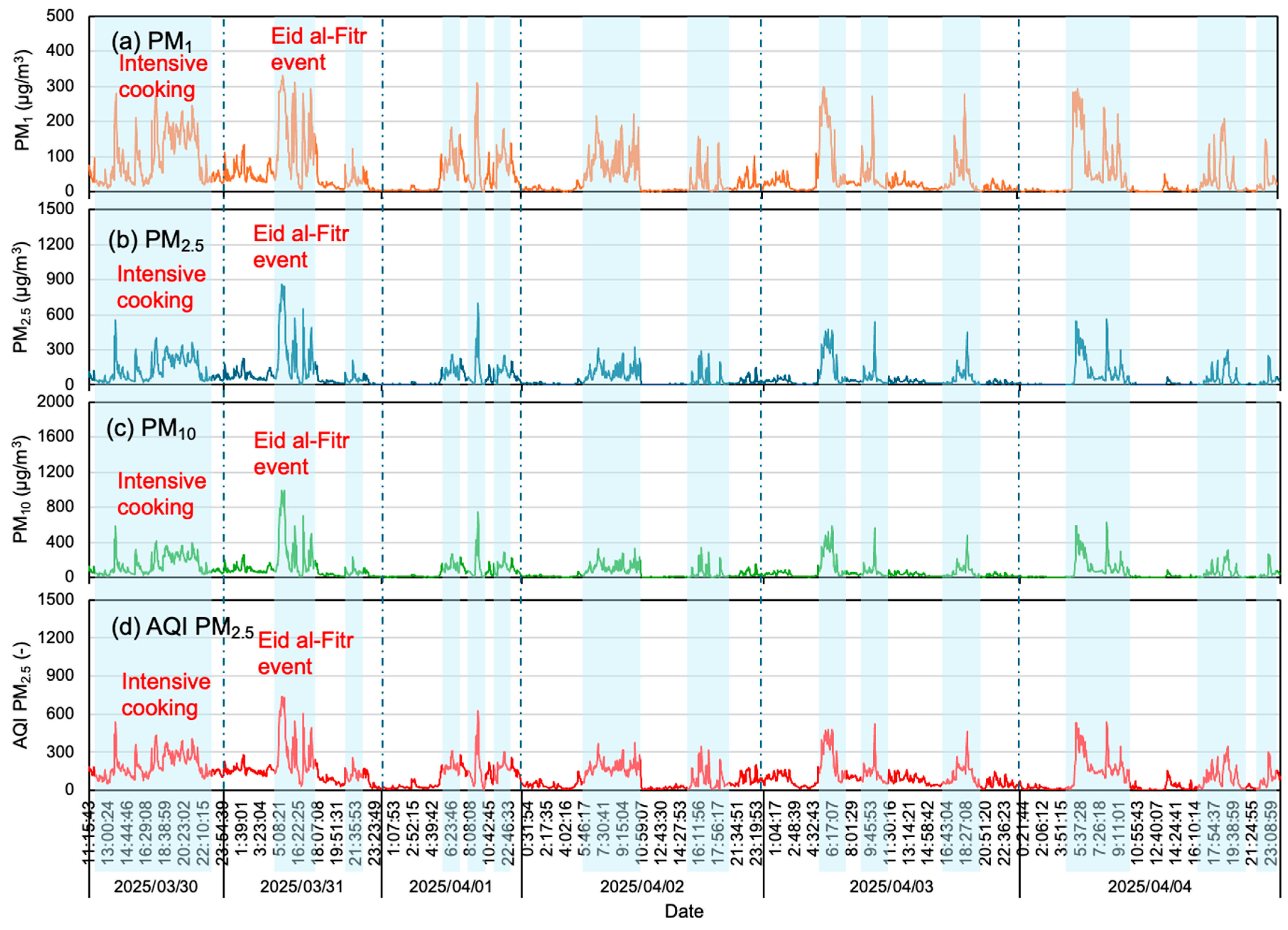

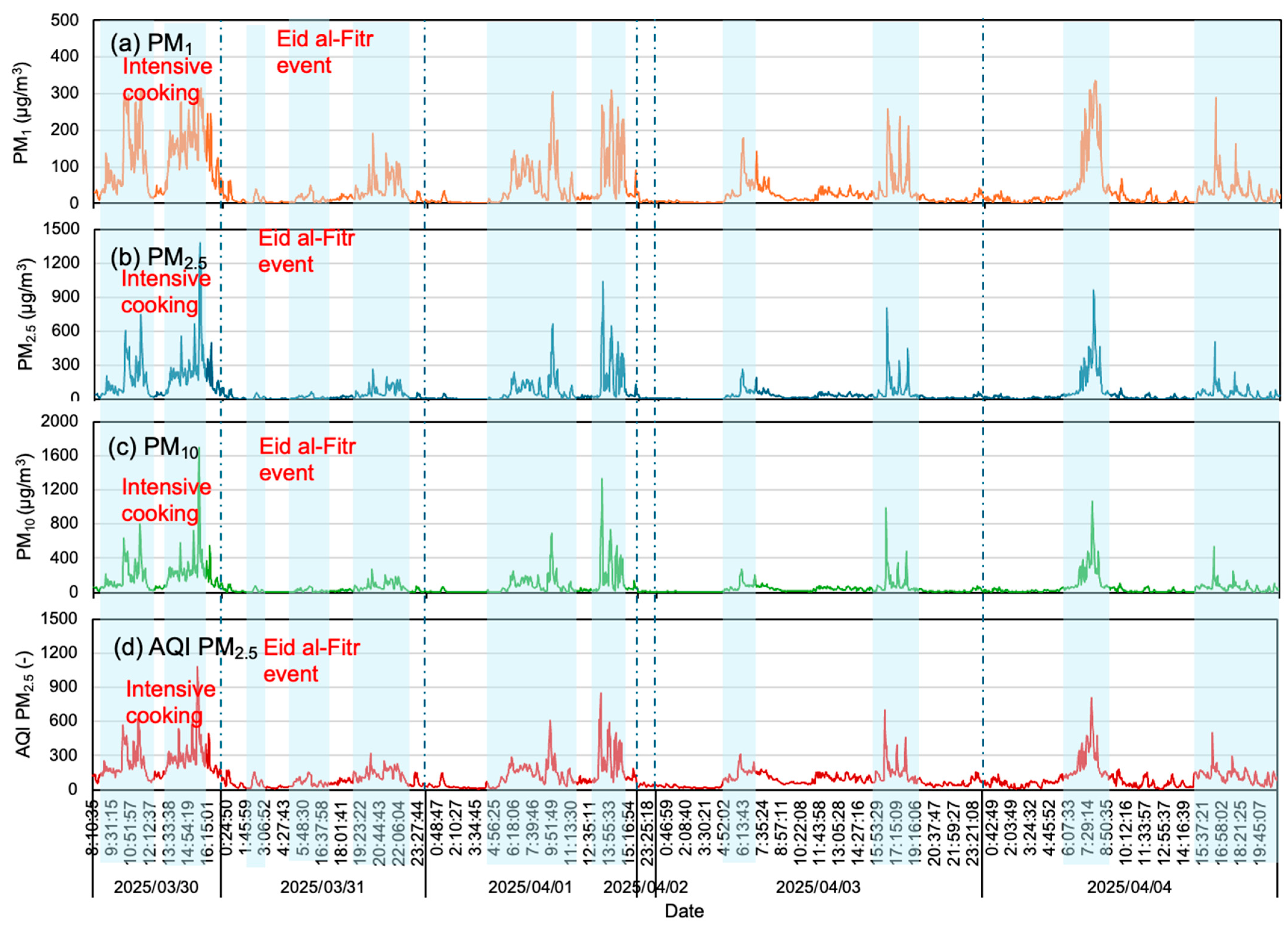
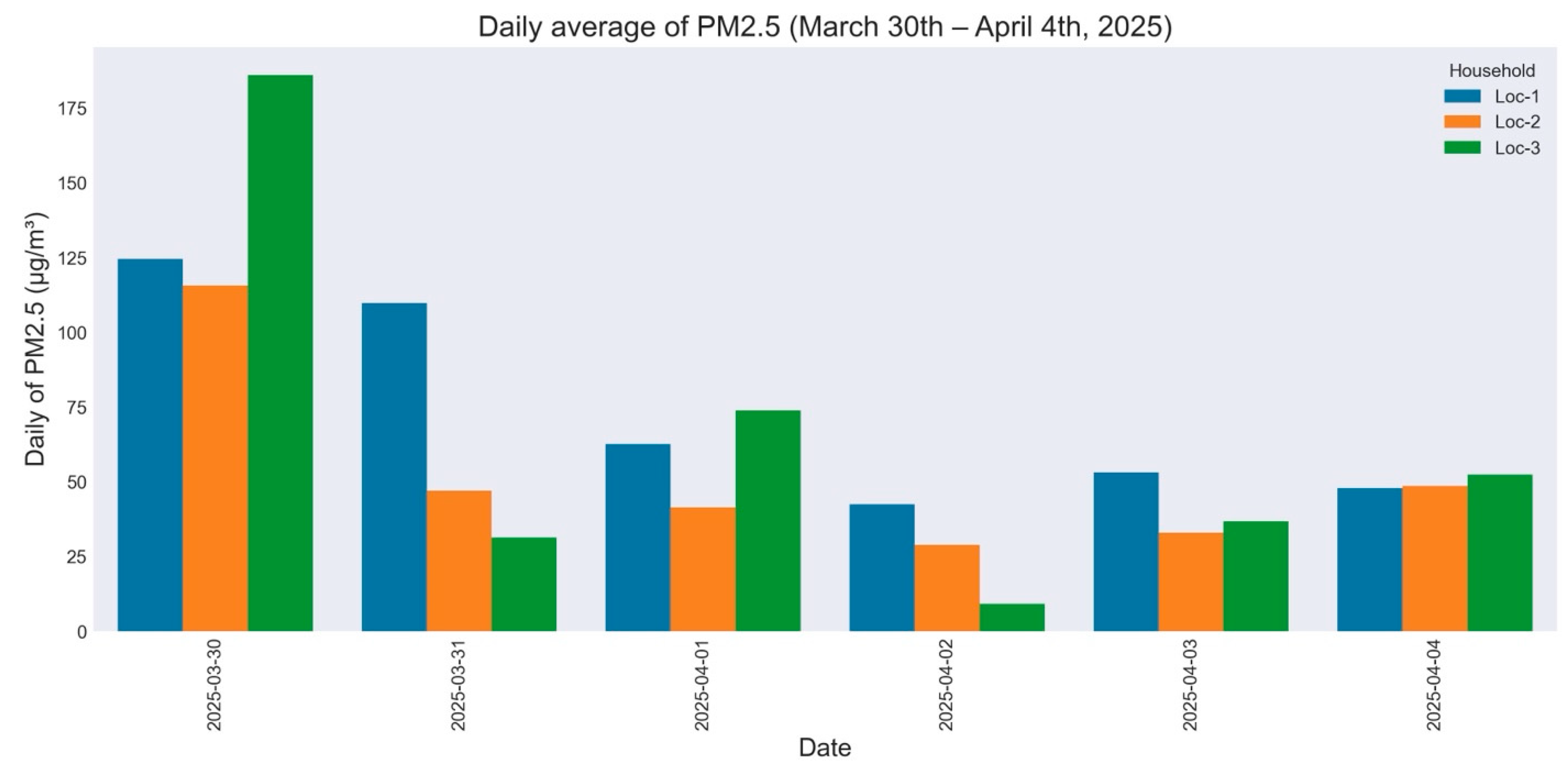
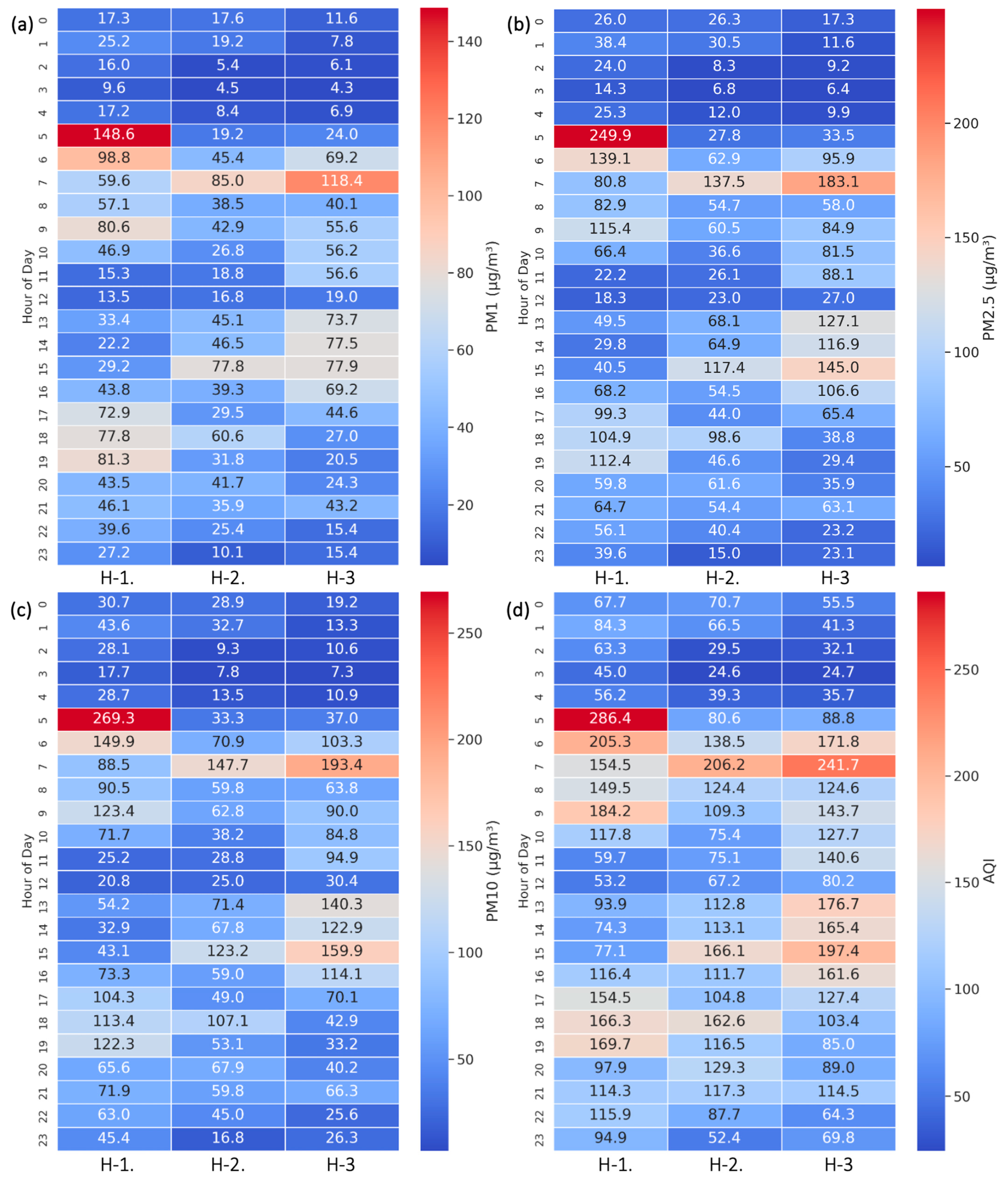
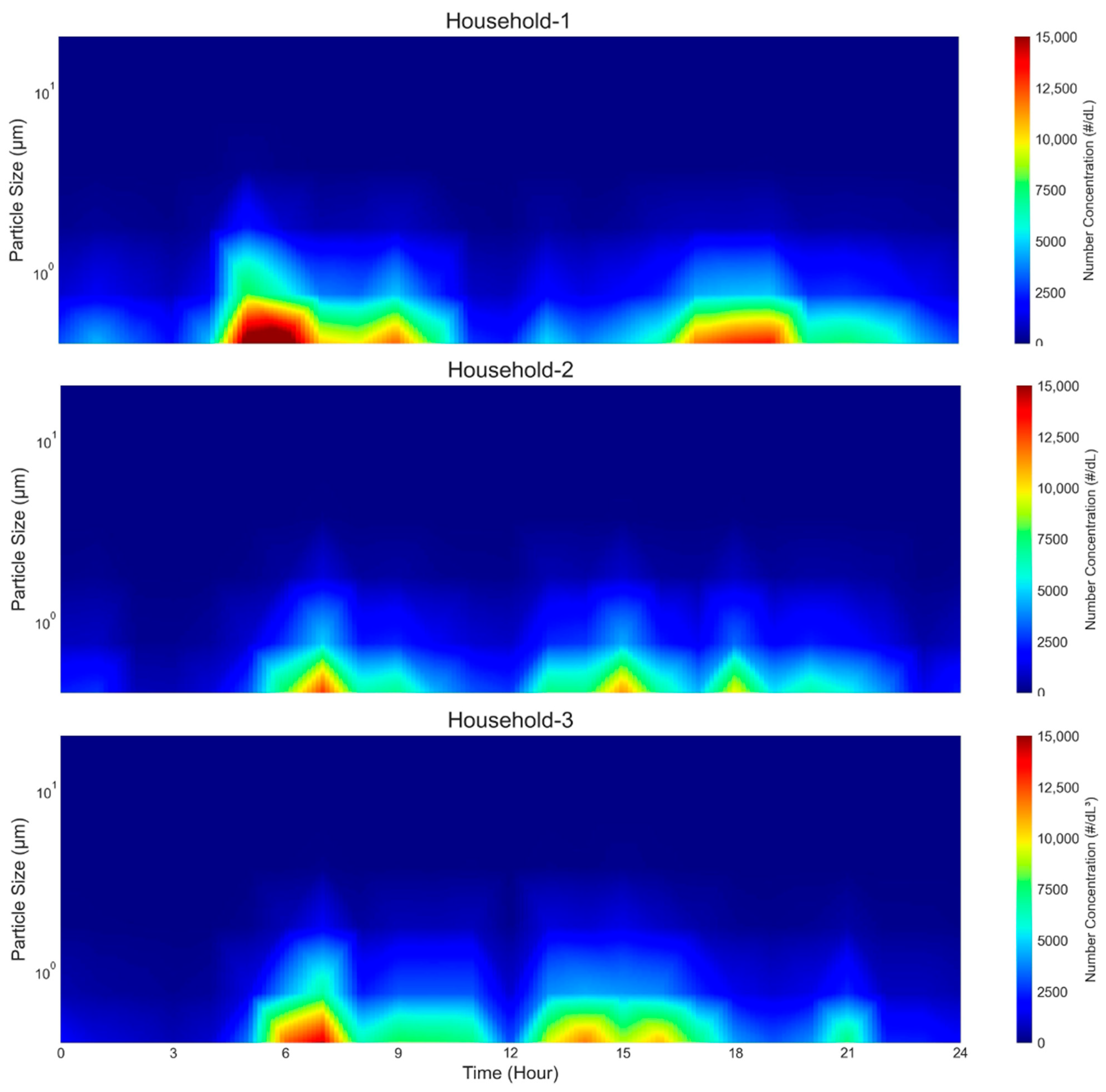
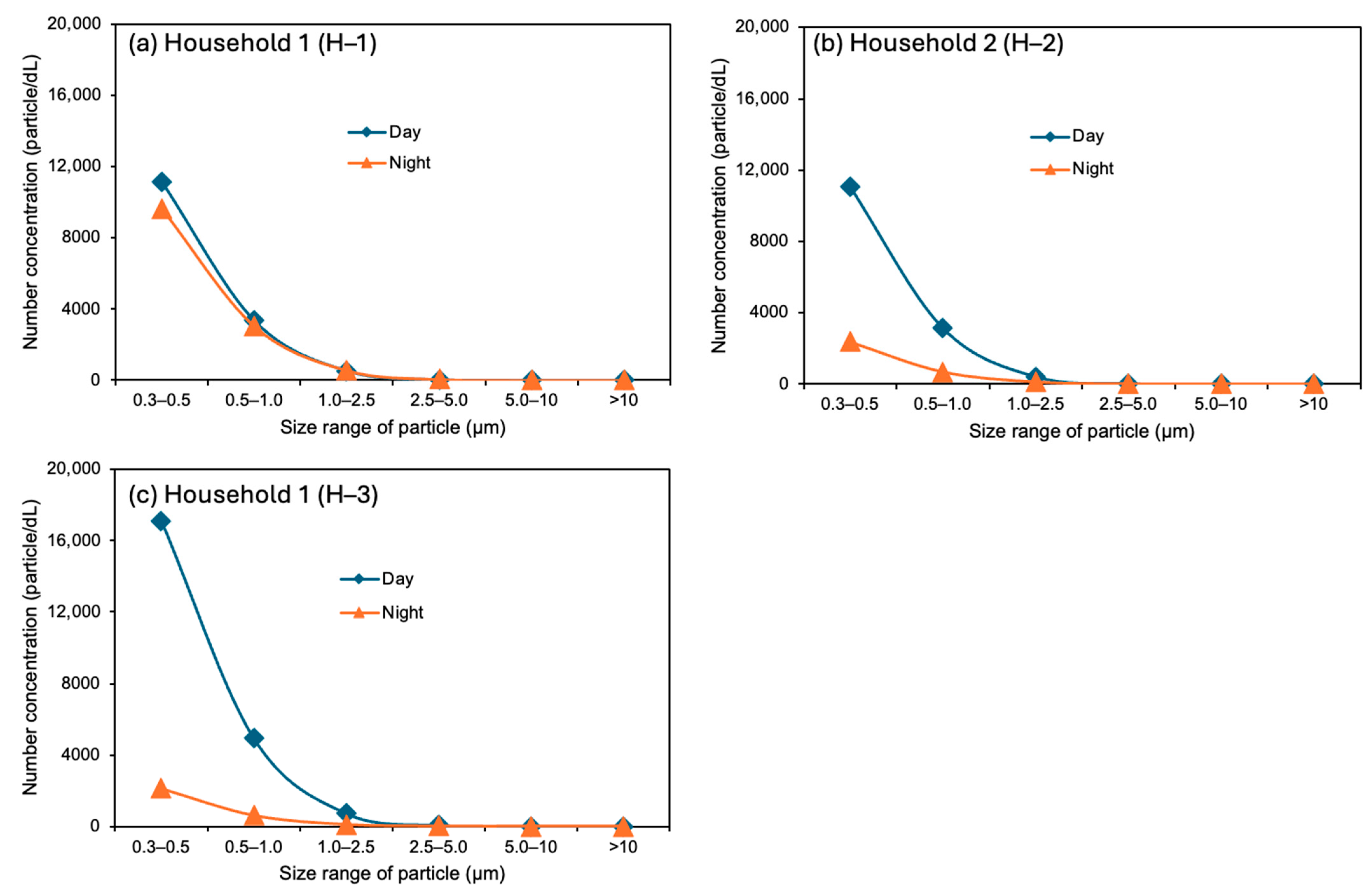
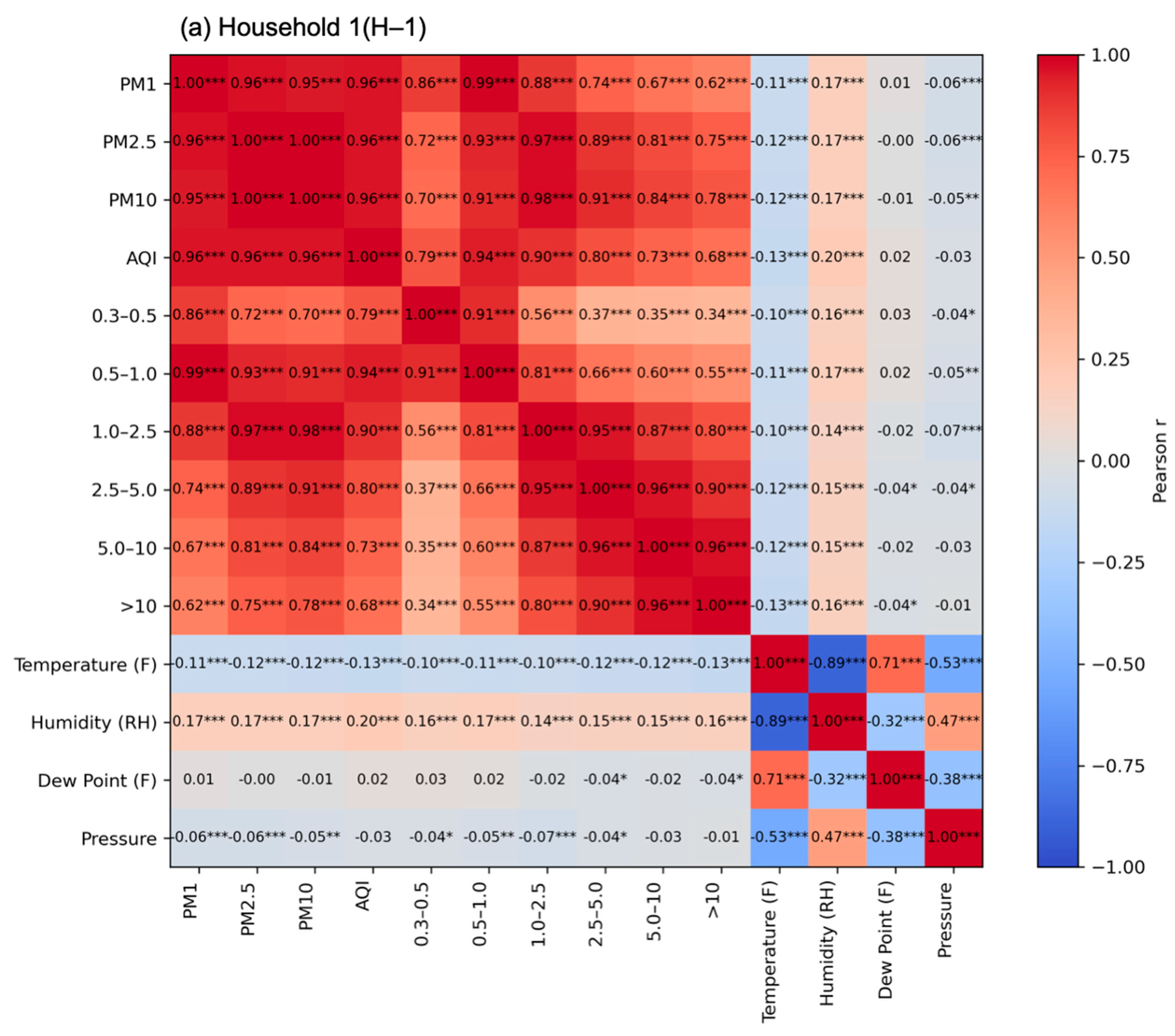
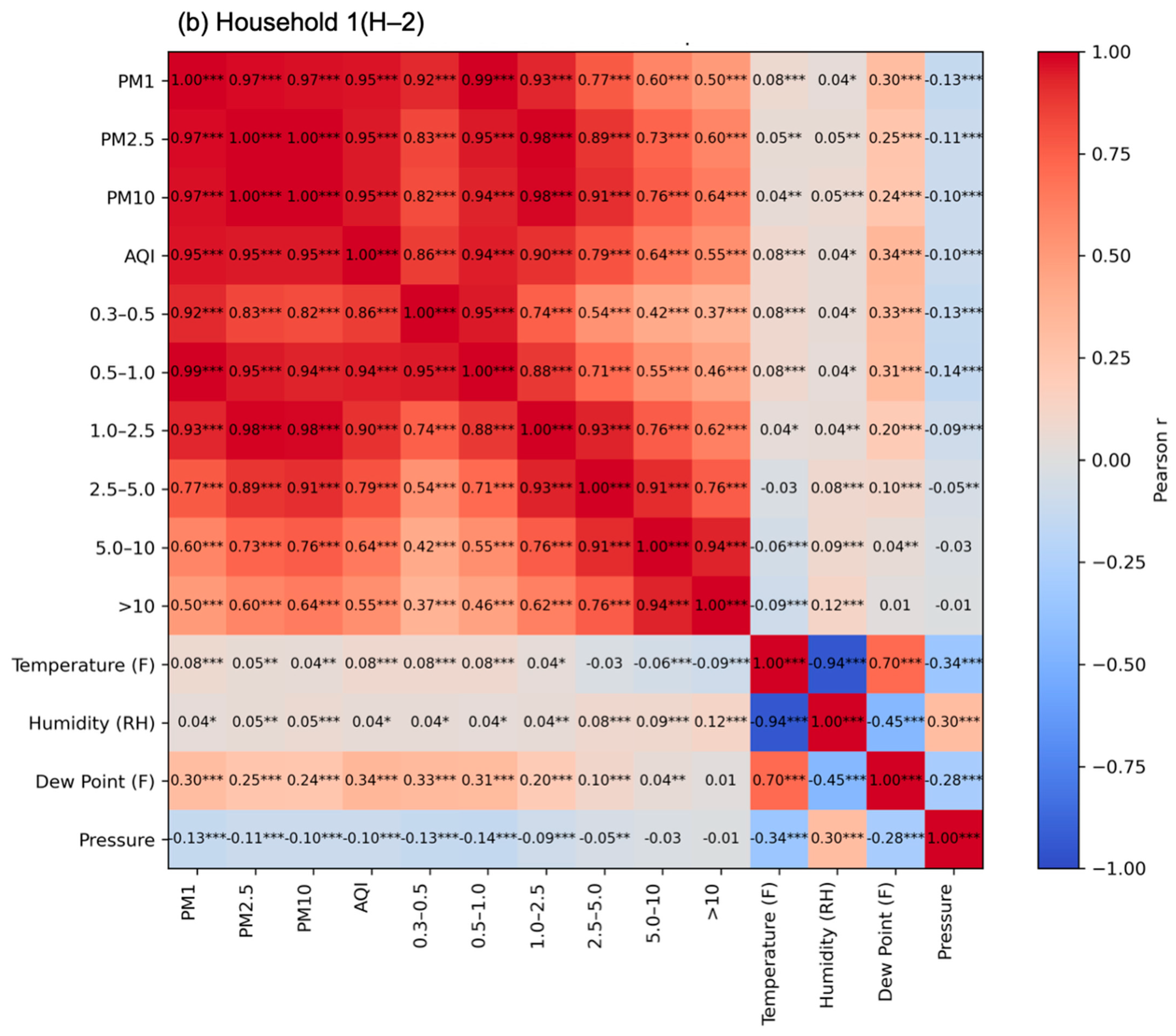

| Time | PM1 (µg/m3) | PM2.5 (µg/m3) | PM10 (µg/m3) | AQI-PM2.5 (–) | ||||||||
|---|---|---|---|---|---|---|---|---|---|---|---|---|
| H-1 | H-2 | H-3 | H-1 | H-2 | H-3 | H-1 | H-2 | H-3 | H-1 | H-2 | H-3 | |
| 00:00–01:00 | 17.3 ± 20.8 | 17.6 ± 20.9 | 11.6 ± 11.4 | 26.0 ± 32.2 | 26.3 ± 33.5 | 17.3 ± 17.6 | 30.7 ± 37.0 | 28.9 ± 35.2 | 19.2 ± 19.2 | 67.7 ± 57.4 | 70.7 ± 50.2 | 55.5 ± 35.4 |
| 01:00–02:00 | 25.2 ± 29.6 | 19.2 ± 33.4 | 7.8 ± 7.2 | 38.4 ± 48.0 | 30.5 ± 57.2 | 11.6 ± 10.9 | 43.6 ± 53.4 | 32.7 ± 59.0 | 13.3 ± 12.8 | 84.3 ± 68.2 | 66.5 ± 70.2 | 41.3 ± 29.8 |
| 02:00–03:00 | 16.0 ± 18.9 | 5.4 ± 6.9 | 6.1 ± 7.6 | 24.0 ± 28.8 | 8.3 ± 10.6 | 9.2 ± 11.6 | 28.1 ± 33.1 | 9.3 ± 11.7 | 10.6 ± 13.3 | 63.3 ± 56.7 | 29.5 ± 28.1 | 32.1 ± 31.1 |
| 03:00–04:00 | 9.6 ± 12.4 | 4.5 ± 6.4 | 4.3 ± 4.3 | 14.3 ± 18.3 | 6.8 ± 9.4 | 6.4 ± 5.9 | 17.7 ± 22.6 | 7.8 ± 10.4 | 7.3 ± 6.0 | 45.0 ± 46.8 | 24.6 ± 25.9 | 24.7 ± 19.6 |
| 04:00–05:00 | 17.2 ± 27.6 | 8.4 ± 10.3 | 6.9 ± 6.1 | 25.3 ± 40.0 | 12.0 ± 15.5 | 9.9 ± 8.4 | 28.7 ± 43.9 | 13.5 ± 17.1 | 10.9 ± 8.8 | 56.2 ± 61.3 | 39.3 ± 36.9 | 35.7 ± 24.9 |
| 05:00–06:00 | 148.6 ± 112.3 | 19.2 ± 13.8 | 24.0 ± 24.2 | 249.9 ± 233.8 | 27.8 ± 20.4 | 33.5 ± 35.1 | 269.3 ± 259.5 | 33.3 ± 26.1 | 37.0 ± 36.8 | 286.4 ± 194.5 | 80.6 ± 38.1 | 88.8 ± 44.0 |
| 06:00–07:00 | 98.8 ± 59.8 | 45.4 ± 33.5 | 69.2 ± 39.6 | 139.1 ± 95.5 | 62.9 ± 45.8 | 95.9 ± 58.7 | 149.9 ± 106.9 | 70.9 ± 46.6 | 103.3 ± 58.9 | 205.3 ± 82.9 | 138.5 ± 44.2 | 171.8 ± 47.1 |
| 07:00–08:00 | 59.6 ± 41.0 | 85.0 ± 62.4 | 118.4 ± 94.8 | 80.8 ± 54.8 | 137.5 ± 145.2 | 183.1 ± 184.5 | 88.5 ± 54.0 | 147.7 ± 157.1 | 193.4 ± 193.5 | 154.5 ± 48.1 | 206.2 ± 113.3 | 241.7 ± 144.4 |
| 08:00–09:00 | 57.1 ± 48.6 | 38.5 ± 26.0 | 40.1 ± 44.3 | 82.9 ± 89.1 | 54.7 ± 38.1 | 58.0 ± 68.0 | 90.5 ± 96.1 | 59.8 ± 38.5 | 63.8 ± 69.7 | 149.5 ± 81.5 | 124.4 ± 42.7 | 124.6 ± 66.7 |
| 09:00–10:00 | 80.6 ± 66.3 | 42.9 ± 57.4 | 55.6 ± 62.4 | 115.4 ± 120.4 | 60.5 ± 85.5 | 84.9 ± 114.6 | 123.4 ± 125.0 | 62.8 ± 86.8 | 90.0 ± 118.9 | 184.2 ± 101.0 | 109.3 ± 91.2 | 143.7 ± 104.9 |
| 10:00–11:00 | 46.9 ± 55.5 | 26.8 ± 44.1 | 56.2 ± 81.6 | 66.4 ± 85.8 | 36.6 ± 61.5 | 81.5 ± 125.9 | 71.7 ± 88.8 | 38.2 ± 63.1 | 84.8 ± 129.4 | 117.8 ± 93.5 | 75.4 ± 73.4 | 127.7 ± 124.2 |
| 11:00–12:00 | 15.3 ± 18.3 | 18.8 ± 16.7 | 56.6 ± 75.4 | 22.2 ± 27.1 | 26.1 ± 23.5 | 88.1 ± 134.0 | 25.2 ± 30.5 | 28.8 ± 26.2 | 94.9 ± 142.1 | 59.7 ± 57.2 | 75.1 ± 46.6 | 140.6 ± 123.1 |
| 12:00–13:00 | 13.5 ± 14.9 | 16.8 ± 16.7 | 19.0 ± 11.3 | 18.3 ± 19.3 | 23.0 ± 21.7 | 27.0 ± 16.3 | 20.8 ± 21.8 | 25.0 ± 23.5 | 30.4 ± 19.3 | 53.2 ± 50.2 | 67.2 ± 43.1 | 80.2 ± 40.8 |
| 13:00–14:00 | 33.4 ± 53.9 | 45.1 ± 73.7 | 73.7 ± 79.6 | 49.5 ± 88.8 | 68.1 ± 119.1 | 127.1 ± 177.8 | 54.2 ± 92.7 | 71.4 ± 122.7 | 140.3 ± 208.6 | 93.9 ± 96.3 | 112.8 ± 121.1 | 176.7 ± 152.0 |
| 14:00–15:00 | 22.2 ± 26.4 | 46.5 ± 62.9 | 77.5 ± 80.4 | 29.8 ± 34.7 | 64.9 ± 94.9 | 116.9 ± 131.5 | 32.9 ± 36.4 | 67.8 ± 96.5 | 122.9 ± 136.9 | 74.3 ± 55.5 | 113.1 ± 97.0 | 165.4 ± 129.1 |
| 15:00–16:00 | 29.2 ± 48.2 | 77.8 ± 79.0 | 77.9 ± 87.8 | 40.5 ± 67.5 | 117.4 ± 139.9 | 145.0 ± 238.3 | 43.1 ± 69.6 | 123.2 ± 148.4 | 159.9 ± 274.9 | 77.1 ± 81.8 | 166.1 ± 132.2 | 197.4 ± 185.2 |
| 16:00–17:00 | 43.8 ± 63.7 | 39.3 ± 43.2 | 69.2 ± 67.8 | 68.2 ± 112.4 | 54.5 ± 62.9 | 106.6 ± 128.0 | 73.3 ± 117.0 | 59.0 ± 64.8 | 114.1 ± 141.5 | 116.4 ± 111.3 | 111.7 ± 73.9 | 161.6 ± 117.7 |
| 17:00–18:00 | 72.9 ± 72.8 | 29.5 ± 32.4 | 44.6 ± 48.3 | 99.3 ± 104.2 | 44.0 ± 57.9 | 65.4 ± 79.0 | 104.3 ± 106.3 | 49.0 ± 63.8 | 70.1 ± 82.1 | 154.5 ± 105.4 | 104.8 ± 60.1 | 127.4 ± 81.9 |
| 18:00–19:00 | 77.8 ± 67.7 | 60.6 ± 58.5 | 27.0 ± 14.6 | 104.9 ± 92.6 | 98.6 ± 116.1 | 38.8 ± 22.4 | 113.4 ± 99.2 | 107.1 ± 123.1 | 42.9 ± 23.9 | 166.3 ± 91.1 | 162.6 ± 104.1 | 103.4 ± 32.7 |
| 19:00–20:00 | 81.3 ± 71.9 | 31.8 ± 20.6 | 20.5 ± 15.3 | 112.4 ± 100.6 | 46.6 ± 32.3 | 29.4 ± 21.6 | 122.3 ± 107.4 | 53.1 ± 35.3 | 33.2 ± 23.9 | 169.7 ± 97.6 | 116.5 ± 42.9 | 85.0 ± 36.6 |
| 20:00–21:00 | 43.5 ± 66.3 | 41.7 ± 42.7 | 24.3 ± 29.1 | 59.8 ± 91.0 | 61.6 ± 65.2 | 35.9 ± 40.5 | 65.6 ± 97.4 | 67.9 ± 66.3 | 40.2 ± 42.5 | 97.9 ± 101.4 | 129.3 ± 64.7 | 89.0 ± 56.1 |
| 21:00–22:00 | 46.1 ± 58.8 | 35.9 ± 46.7 | 43.2 ± 40.0 | 64.7 ± 82.3 | 54.4 ± 77.4 | 63.1 ± 58.5 | 71.9 ± 88.7 | 59.8 ± 78.4 | 66.3 ± 60.1 | 114.3 ± 91.9 | 117.3 ± 76.0 | 114.5 ± 70.2 |
| 22:00–23:00 | 39.6 ± 38.0 | 25.4 ± 36.5 | 15.4 ± 19.9 | 56.1 ± 54.1 | 40.4 ± 63.7 | 23.2 ± 31.2 | 63.0 ± 58.0 | 45.0 ± 69.4 | 25.6 ± 32.9 | 115.9 ± 64.0 | 87.7 ± 70.2 | 64.3 ± 45.8 |
| 23:00–00:00 | 27.2 ± 26.4 | 10.1 ± 7.0 | 15.4 ± 13.3 | 39.6 ± 38.5 | 15.0 ± 11.1 | 23.1 ± 20.5 | 45.4 ± 42.0 | 16.8 ± 12.9 | 26.3 ± 23.1 | 94.9 ± 57.1 | 52.4 ± 27.7 | 69.8 ± 42.4 |
Disclaimer/Publisher’s Note: The statements, opinions and data contained in all publications are solely those of the individual author(s) and contributor(s) and not of MDPI and/or the editor(s). MDPI and/or the editor(s) disclaim responsibility for any injury to people or property resulting from any ideas, methods, instructions or products referred to in the content. |
© 2025 by the authors. Licensee MDPI, Basel, Switzerland. This article is an open access article distributed under the terms and conditions of the Creative Commons Attribution (CC BY) license (https://creativecommons.org/licenses/by/4.0/).
Share and Cite
Amin, M.; Bachtiar, V.S.; Hanami, Z.A.; Hustim, M. Characterization of Particulate Matter in Indoor Air from Cooking Activities in Rural Indonesian Households. Atmosphere 2025, 16, 1124. https://doi.org/10.3390/atmos16101124
Amin M, Bachtiar VS, Hanami ZA, Hustim M. Characterization of Particulate Matter in Indoor Air from Cooking Activities in Rural Indonesian Households. Atmosphere. 2025; 16(10):1124. https://doi.org/10.3390/atmos16101124
Chicago/Turabian StyleAmin, Muhammad, Vera Surtia Bachtiar, Zarah Arwieny Hanami, and Muralia Hustim. 2025. "Characterization of Particulate Matter in Indoor Air from Cooking Activities in Rural Indonesian Households" Atmosphere 16, no. 10: 1124. https://doi.org/10.3390/atmos16101124
APA StyleAmin, M., Bachtiar, V. S., Hanami, Z. A., & Hustim, M. (2025). Characterization of Particulate Matter in Indoor Air from Cooking Activities in Rural Indonesian Households. Atmosphere, 16(10), 1124. https://doi.org/10.3390/atmos16101124










